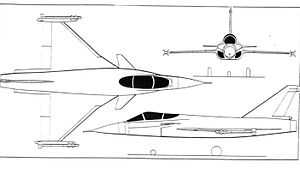Novi Avion
The Novi Avion (English: New Aeroplane) was a 4th-generation, supersonic multi-role combat aircraft of cropped delta-canard planform, designed by Vazduhoplovno Tehnicki Institut (VTI) of Yugoslavia but cancelled just before production began in 1991.
Overview
The project was started in the mid-1980s in order to make Yugoslavia fully self-sufficient in the manufacture of military equipment, and air superiority fighter jets were the only thing that Yugoslavia still had to import, having obtained the capability to build all other military equipment (tanks, light attack jets, submarines, etc.) by the 1980s. When Yugoslavia disintegrated in 1991, the project was cancelled, since the break-up of the country made the financial resources necessary to start production of the plane unavailable.
The design was approximately one year from completion at the time of cancellation, and design of some production facilities and prototypes of some parts such as the cockpit had already been built. Had it not been cancelled, it would have had its first flight in 1992, and entered service some time in the mid or late 1990s. The work was undertaken by the Vazduhoplovno Tehnicki Institut (VTI) ("Aeronautical Technical Institute") of Belgrade, Yugoslavia's main military-technical institute.
Yugoslavia expected to build approximately 150 of these planes to replace its MiG-21s and J-21 Jastrebs, and a sale of several hundred Novi Avions on the world market was also anticipated. The term Novi Avion, which was used to describe the project, means "new aircraft" in Serbo-Croatian, although the aircraft would have received a proper designation upon entering service.
Design
The Novi Avion most closely resembled the French Rafale,[citation needed] although it was smaller and had only one engine. It was designed to fill many roles, including air superiority, interception, reconnaissance, ground attack, and anti-ship attack. Maximum speed was just under Mach 2. Super-maneuverability at both supersonic and subsonic speeds was a priority, and a major portion of the airframe was to be composed of composites.
The design was to incorporate a number of features to lower its radar cross section, although it would not have been a true stealth aircraft. The aircraft was to carry an advanced ECM/ECCM suite. It was an all-Yugoslav design, not based on any foreign plane, although France was providing some assistance with the design of the most complex parts that Yugoslavia had no experience with, such as a multipurpose radar.
The engine was to be the French Snecma M88, the same engine used in the Rafale. Most of the weapons it would have carried would probably have been either French weapons, or built with French assistance.
Specifications

General characteristics
- Crew: 1
- Length: 13.75 m (45.1 ft)
- Wingspan: 8.00 m (26.2 ft)
- Height: 4.87 m (15.9 ft)
- Wing area: 30 m² (322.9 sq.ft)
- Empty weight: 6,247 kg (13,772 lb)
- Max. takeoff weight: 13,400 kg (29,542 lb)
- Powerplant: 1 × Snecma M88 turbofan
- Dry thrust: 50.04 kN (11,250 lbf)
- Thrust with afterburner: 75.62 kN (17,000 lbf)
Performance
- Maximum speed: Mach 1.88 (1,243 mph [2,000 km/h])
- Range: 3,765 km (2,339 mi)
- Service ceiling: 17,000 m (55,775 ft)
- Rate of climb: 16,500 m/min ()
- Wing loading: 446.67 kg/m² ()
- Guns: 1× 30 mm cannon
- Hardpoints: 11 total (including 2× wing-tip hardpoints for infra-red homing air-to-air missiles)
Avionics
- Fire-control radar
- Digital flight control system
- Multi-function navigation/attack system
- Glass cockpit
See also
- Related lists
References
External links
- Novi avion at vazduhoplovnetradicijesrbije.rs, retrieved 4-12-2013 (Serbian)
| ||||||||
| ||||||||||||||